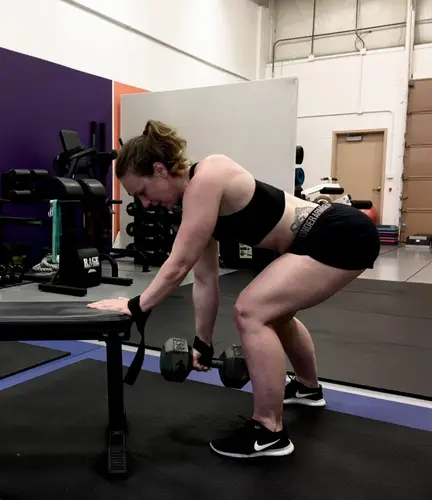Cardio and Aerobic.
Anyone who has ever gotten to a gym, or watched any workout video has heard about Cardiovascular and Aerobic. Different exercises seem to aim at various targets; therefore, people are quick to associate some machines or activities with a specific type of training. But sometimes things are not so black and white.
Think about your answer: What type of exercise are Squats, walking, and running, respectively?
Cardiovascular exercises: Are intended to strengthen up the heart and overall circulatory system. Activities that keep the heart-rate above 65% are considered Cardiovascular activities.
Aerobic exercises: Are intended to burn the maximum amount of fat (percent wise). Those are activities that keep the heart rate under 65%.
Are often recommended to people with some sort of heart condition or health concern.
To understand the whole picture, let’s start by explaining the heart rate percentage. The general formula, perhaps no extremely accurate but a good start, is:
(220-Age-Resting Heart Rate) x percentage + Resting Heart Rate.
Lets picture two fictional characters:
Subject A is 33 years old, with a resting heart rate of 40 bpm.
Subject B is 60 years old, with a resting heart rate of 90 bpm.
After applying the formula, we realize that 65% of their max heart rate is the same, but we are missing a factor, which is fitness level.
Based on their resting heart rate, it’s safe to conclude that Subject A is an athlete, while Subject B would, most likely, have a more sedentary lifestyle.
The evident difference will be in the performance. Subject A would get to 135 bpm while exercising a much higher intensity than Subject B. Therefore, walking on the treadmill at 4MPH may be a very light aerobic for Subject A, while it could be medium-to-high intensity cardio for Subject B.
TYPE OF ACTIVITY BASED ON THE ENERGY SOURCE.
It’s not uncommon to hear about fat-burning exercises or “zones.”
The body has two sources of energy: fat and glycogen (carbs), virtually every activity will burn calories from both sources, but at a very different rate.
The amount of energy required to move a mass a specific distance will be the same regardless of the speed, as long as all the elements (friction, air resistance, etc.) remain the same. Consequently, we burn essentially* the same amount of calories to move our bodies one mile, despite if we do it strolling, walking fast, or sprinting.
*Sprinting adds the element of bouncing, which adds a minimal difference to the number.
ANAEROBIC
To sprint, the human body resources to the glycogen for energy. Still, that won’t be the only source of energy the body will use, it will also retrieve a very small percentage from the fat deposits. The process of utilizing anaerobic energy leaves a byproduct behind (lactic acid), which blocks the cells temporarily—the higher accumulation of lactic acid, the more significant number of muscle cells that cannot operate until the lactic acid is removed from the cell.

Usain Bolt holds the record for 100 meters at 9.58 seconds, but he cannot run ten times that distance (1 kilometer) in ten times the time (95.8 seconds).

As a matter of fact, the record for 1 kilometer is 2:11.96 (almost 132 seconds), by Noah Ngeny.
What is the reason for the 32% discrepancy?
The accumulation of lactic acid blocks some muscle fibers, consequently, Ngeny must balance between the energy used from glycogen and the energy used from fat (a system that has CO2 as a byproduct) to be able to cover the distance in the most efficient way, but without blocking all the muscle cells (often referred as “hitting the wall”).
You may have seen a long-distance runner limping and running with stiffed legs while trying to keep going, now you know that’s the product of the excessive accumulation of lactic acid.
AEROBIC
Most of the activities we perform during the day are aerobic. Anything that keeps our heart rate under 65% is considered aerobic, meaning that it utilizes most of the energy from fats combined with oxygen. But once again, nothing is as simple as black and white, just walking to the mailbox and back will utilize some amount of glycogen (even minimal).
Utilizing the most abundant source of energy (fat), while leaving a byproduct that causes no impairment to our performance, aerobic activities are characterized by allowing the performer to execute them for a very long period.
FAT BURNING EXERCISES
Internet videos, TV commercials, and magazines are plagued with exercise programs and equipment offering the “ultimate fat-burning workout“, “up to 600 calories per hour“, and alike…It’s worth looking at these claims closely.
ANALYZING THE FACTS
THE ULTIMATE FAT BURNING
On average, a 175lb person will utilize around 100 calories to cover one mile on foot. If that person decides to make it in the quickest possible way, they will be finished with the first mile in a little more than 2 minutes (It would be helpful to be named Noah Ngeny). Still, most of the calories utilized would be from glycogen, and most likely, they won’t be able to continue (even at a moderate pace).
On the other hand, if the person decides to go at a slow pace, it may take 30 minutes to cover the first mile, and most of the calories spent will be from fat. Additionally, the person will likely be able to continue at that pace for many more miles, burning many more calories.
BURNING CALORIES RAPIDLY
To burn 600 calories per hour, a 175lbs person would require a workout routine equivalent to running at a constant pace of 6MPH (the speed must be higher for a lighter individual).
It’s an intensity that a fairly fit person can perform for an hour, but very likely, they will burn most of the calories from glycogen (depending on how high their heart needs to beat to keep up with the activity).
ADDITIONAL NOTE

RESISTANCE TRAINING
Resistance training also makes it to the list of activities to consider. A resistance training routine is formed by motions the body cannot perform for over 45 seconds at the time, followed by a period of recovery before being able to repeat the action. Most of the calories consumed will be from glycogen (and only a small percentage from fats).
During the performance, the heart can get to pretty high levels (up to 90%), which could be a risk factor for some individuals. The challenge will push the muscles to change by adaptation, growing stronger to manage the load (after eating and resting). Although it is not often referred to as a cardiovascular activity, it offers the same benefits for the heart and circulatory system.
It burns high amounts of calories from glycogen (while the activity is being performed). A routine of 6 exercises, and 3 sets per exercise, will burn calories for 13 minutes (at best). Clearly, it’s not the best activity to burn calories, but that’s not the intended benefit.
Resistance training offers a great benefit to improving the stability, performance, and mobility of the joints, increasing the Basal Metabolic Rate (calories from fat we burn while resting), increase bone density, and shape the body.
